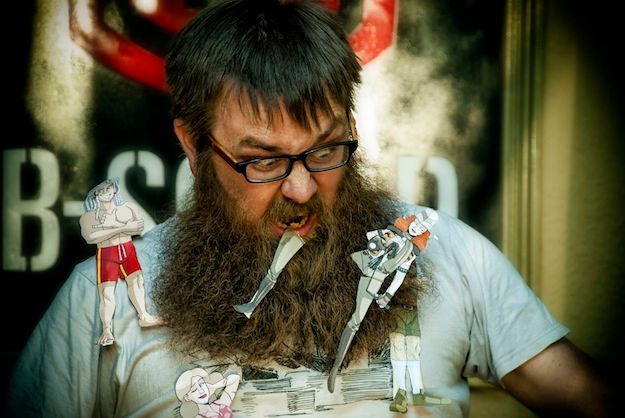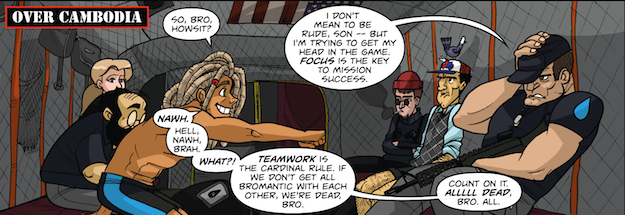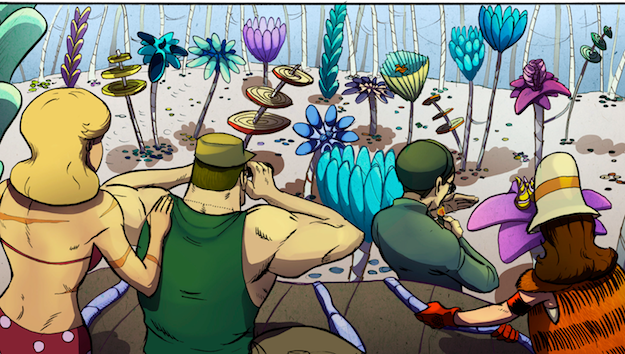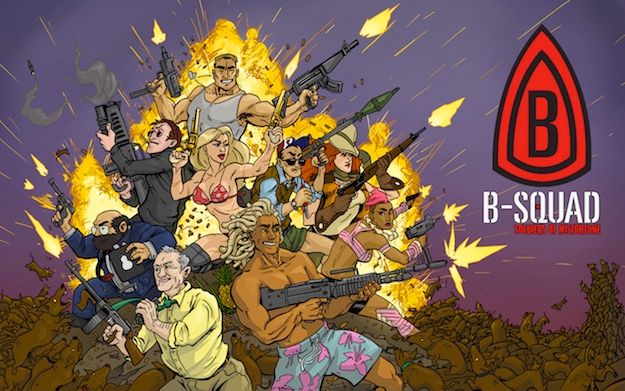Eben Burgoon's goofy comedy The B-Squad is the story of a ragtag crew sent off on various missions around the world. He brings considerable comedic energy to the story, and the twist is that a member of the squad is killed off in every issue. Burgoon chooses who to kill at random by (in real life) spinning an antique sailor's gambling device made of whalebone.
The first issue was funded on Kickstarter, and you can download it for free from the shop at the B-Squad website. Now Burgoon is running another, more ambitious Kickstarter to fund the rest of a six-issue run and print it as a graphic novel. In Issue 2 (which was privately funded) and Issue 3, the story takes place in Tapigami, the masking-tape world of real-life artist Danny Scheible; the team is sent to rescue Bill Murray, who has been kidnapped by the artist.
This is Burgoon's third Kickstarter: After his first campaign to fund the first issue failed to reach its goal, he brushed himself off and did it again, this time successfully. So in addition to talking about the comic and where it is going, in this interview we asked him to talk about what he learned from his crowdfunding experiences.
Robot 6: So, the B-Squad is sort of the opposite of the A-Team, right? What was the spark for that idea?
Eben Burgoon: Yeah, like a discount version -- the Blue Light Special in the back of Soldier of Fortune magazine. The spark really was born out of my love of the '80s and '90s action and adventure movies and television shows, but as I sat down to make my dream squad, but I found myself wanting to make more and more. Too many. I needed something to chew through them. I thought that killing them off would be a little crazy, but it occurred to me life is kinda like that — humanity has a lot of impermanence and change, and our world is full of ultimately mortal heroes; loss is part of life. So the squad, a community, can survive a loss and still be exciting. That sounded a lot more fun to write and I can use B-Squad as a vehicle to poke fun at society and action tropes — and inject this wild creative writing challenge of doing the deadly deed with a spinning dice made out of whalebone.
You start out with a crazy bunch of characters, and you kill one off every issue. It must be quite a challenge coming up with new characters that rise to a certain level of goofiness. How do you do that? Are they based on people you know, and if so, has that gotten you into trouble?
Just about all the future characters are all templates, most can swap genders, too. I usually give my characters a little piece or tidbit of my personality or one of my interests, and that's my starting point into their head. Some of them surely have gotten pieces of other characters. Each character is made up of those little pieces and I just twist the hell out of it in my head until the Rubik's Cube is solved ... or really, mostly solved — they need to be more than a little flawed to work for a discount mercenary service. I know Brodee's look was based on a white guy with dreadlocks I saw in the audience at a Dave Chapelle standup show in Sacramento. For the other guys, I haven't had anybody notice when I borrowed pieces of them for my characters yet. One of our Kickstarter backers was illustrated into the comic, and MacGoogle killed her with a cell phone — she loved it so much she backed the Volume 1 Kickstarter to be in every issue!
Also, does every issue start with a funeral?
Yep. That's sort of the Law & Order procedural part of B-Squad. [It] lets the characters left over give out some closure, and it's my last time with the character — a chance to give some resolution to stray threads and reveal a little about how they came to B-Squad. Issue 1 starts with a funeral for what will come to be a very important character for the series.
We wrote a few weeks ago about your work with children at 916 Ink. Has being around kids affected the way you make comics?
As much as I would like to say "No, I'm a superhuman genius and can keep those world separate," I don't think that's possible. They've inspired me to take more risks with my writing and be more confident about getting over the top. They are incredibly inspiring and constantly test me. We're doing the program again this Fall and I can't wait to do it. I feel extraordinarily lucky how well that program worked out.
One of the kids read B-Squad and asked me if he could do a B-Squad story for the 916 Ink comic book. It's in the final book, and that may be the highest honor in comics.
Why are you working with a different artist for each issue of this series, as opposed to sticking with just one?
Lauren Monardo has been an utter thrill to work with on Issue 1, and shortly after she finished it and we were getting ready to do Issue 2, she got a very serious job offer and couldn't side-gig B-Squad. I'd been toying with the idea that using a different artist for every story would also give an extra air of impermanence and change — a central theme. When Jon Williams said he'd be up for doing issues 2 and 3, and I saw how different, but still the same, the characters were. That really made the decision for me. My hope is B-Squad can be a proving ground for rising talent in comics and, occasionally, we get that big name. Sean K. Sutter and Junior Bruce are incredibly talented, and I'm excited about working with them. I have dreams that I'll get Lauren back and have her sister, Carly Monardo, do the colors. I'd love to have Jordie Bellaire color for an issue, or get Rob Guillory to do an issue. I love all their work so much. The collaboration of creating comics is why I left writing fiction behind and I want to share B-Squad with more collaborators.
The real big hope is B-Squad takes off. After I do 36 issues, I'd pass the writing job off to a new writer, they'd get all the same characters, start with those same first six guys, and roll the dice all over again with different missions.
You have had a couple of Kickstarters, in the past, one successful, one not. Can you explain what you did differently the second time around? What did you learn?
The key difference far and away was that I backed myself. I took my tax return and gave it to Lauren and said, "Make as much art as you can." The first time was a whirlwind of rookie mistakes and premature missteps — but I was full of moxie because I loved the project and knew it would be great. Failing is certainly discouraging, but I am good at seeing my faults, like any good writer. Fortunately, the people around me reached out and encouraged me to do it again.
I also asked for help the second time around. I had a good support network, and people were excited to help me. Our letterist Michael Finn has been a huge help in that department. We threw a big party to celebrate B-Squad in the downtown mall of Sacramento, had our first cosplayer, and there was just a more celebratory attitude. There was a lot more confidence and excitement and it was a lot easier to hit our goals.
I also ran the campaign in December. I honestly think people are shopping for gifts that exist in December, not promises of gifts to be created later.
Why did you decide to move toward a graphic novel rather than using Kickstarter to fund one issue at a time?
I'd rather ask the fans to pay for it all once, and if I can have the artists all working together at the same time on the same book, it'll come out sooner. It's like binge-watching, but for comic books. I can bring out a new season of B-Squad a whole lot faster.
A lot of the comic book advice I read also says that comic book fans are growing too savvy for single issues and are often in "wait for the trade" maxim. I know I suffer from that binge reader syndrome.
How are you finding your audience and connecting with new readers -- via the web, social media, personal appearances?
All three. It's got to be. We don't do a lot of conventions, honestly. I try to do shows where I might be somebody's first comic book or their gateway back into comics. Especially locally in Sacramento or create my own opportunities. In Sacramento, I teamed up with the major art museum to create a comic book arts night. We'll have Crocker-Con the same night as the Kickstarter ends on Sept. 11 with about 30 other Sacramento and regional comics. We'll be doing APE in SF and ZappCon in Fresno for October and definitely Wizard World when they come to Sacramento. I'm optimistic we'll do San Diego 2015, maybe Stumptown and Emerald City, too.
Once the Kickstarter is over, will the comic still be available to new readers? How? Do you have any distribution plans?
We'll have it for sale through the online store for sure, and we'll probably keep issue 1 available as a free download. I'll definitely submit it through to comiXology. We definitely aim to get it into comic book stores and make more convention appearances. Just keep on growing as far as we can.
Honestly, I'd love to get a publisher for B-Squad. I'm sure Image, Dark Horse and Oni probably have our pitch somewhere in their mountain of hopefuls. I have lofty hopes to convince Marvel to let me write a Star Wars idea I have — it's really good. Some day. I suppose if somebody reading thinks this bearded goof looks fun and I like the cut of his jib... well, I suppose there's a divine plan in that, too. Optimistically, we're hoping enough people will see the value of this idea and we get to see B-Squad: The Series on Adult Swim or even on Netflix or Hulu. Onward and upward. Baby steps before we leap out to the stars.




